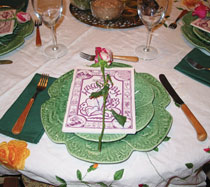Issue Archive
Commentary: The Third Seder

The 5th anniversary of my diagnosis with stage IV bladder cancer has just passed. I underwent six months of chemotherapy and extensive surgery, but today I am fully back in my life, having finally graduated to annual examinations. This means my doctors think I am fine. But there is so much to reconcile. I went from being fine to being diagnosed with cancer, then undergoing long invasive treatment and now being told I am “fine” again. How does one trust feeling well once more?
Recovery from cancer is complex. The memory of pain and fear remains. We see the world through those events and are compelled to tell our stories. The family members who went through it with us do not want to hear the saga again; they want us to be as before. But that cannot be; there is a new normal for us. We know we could have died and we may yet die at the hands of some sleeper cancer cells.
My family and i host two traditional Seders at home. But the liturgy and order of the Seder is uniquely appropriate to dealing with cancer survival issues. Liberation comes from retelling. For me the real miracle is that in spite of everything that has happened to us and our people historically and personally, we have survived once more to sit at the table and tell our story.
I host a third Seder with fellow travelers, women cancer survivors who share the same intimate knowledge of mortality. All of us share the cooking and the readings. We are of different ages, religions, cancer diagnoses and survival anniversaries. We celebrate by exploring the historical and personal meanings of the traditional symbols, and by sharing not only our memories but also our plans for renewal and fresh opportunities and, especially, hope.
We use the Santa Cruz Haggadah, which interprets the Seder rituals to explore themes of personal growth, health and healing; and examines the perceptions, habits, feelings and relationships that enslave or harm us. It celebrates the courage to undergo transformation, to let go of the shore, to do what needs to be done to make the transition to health and the future. We recite: “Our bodies were slaves in Mitzrayim…and there may be ways in which we feel as if our physical beings are entrapped now…in illness.” It is also a feminist Haggada, focusing on the role of women in the Exodus and on themes of birth, rebirth and connection. The San Diego Women’s Haggadah is another resource; it speaks of the Almighty as the midwife assisting in our rebirth and transformation into freedom and health.
At the table we pour water over each other’s hands to wash away the negative feelings; ask the Four Questions and ponder their meanings; drink the four cups of sweet wine, savor the matza and bitter herbs; explain the symbols of the Seder plate; and relate our personal cancer-related Ten Plagues.
We say Sheheheyanu, a simple but powerful blessing recited on holidays and on good occasions and milestones. It has special significance for us: We thank the Almighty for allowing us to reach this season. We share the fears and difficulties of life after cancer; we know that each moment, each day, each year of freedom from cancer is precious.
Our annual remembrance photograph of Seder participants salutes these women of valor. Looking forward to our 5th annual Seder, we pray: May we all sit at the Seder table again this year.
Karen Greene, Ph.D., is a clinical psychologist in New York specializing in postpartum disorders and trauma. Her forthcoming book is titled Surviving Cancer Via E-mail: How I Did It With a Little Help From My Friends.










 Facebook
Facebook Instagram
Instagram Twitter
Twitter
Leave a Reply